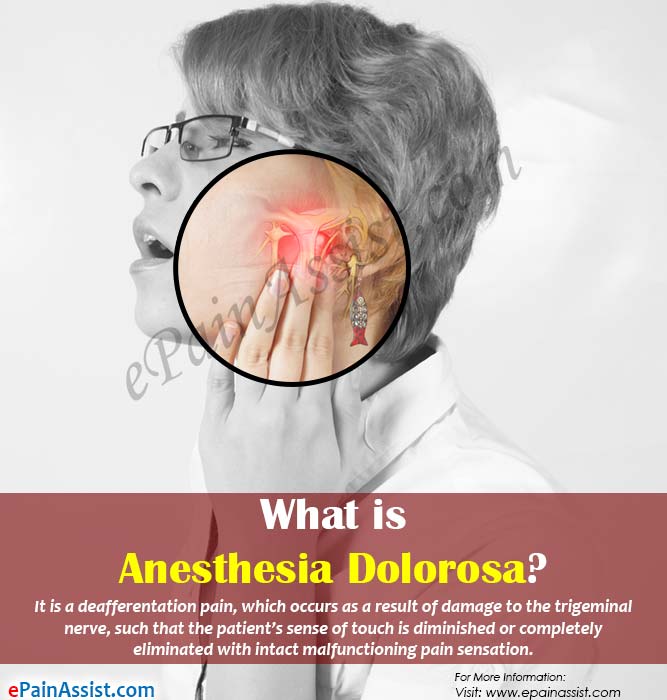What is Anesthesia Dolorosa?
Anesthesia Dolorosa (AD) is a deafferentation pain, which occurs as a result of damage to the trigeminal nerve, such that the patient’s sense of touch is diminished or completely eliminated with intact malfunctioning pain sensation. Anesthesia Dolorosa is also known as deafferentation pain syndrome.
In Anesthesia dolorosa the patient feels pain in an area (usually on the face) which is completely numb to touch. The pain can be characterized as burning, constant, severe or aching in nature. Anesthesia dolorosa can occur as a side effect of surgery, which involves any part of the trigeminal system. As of now there has been no discovery of an effective medical therapy for Anesthesia Dolorosa. There have been several surgical techniques attempted with mixed results.

What Causes Anesthesia Dolorosa?
Anesthesia Dolorosa can be caused from any surgery performed on or involving the trigeminal ganglion. The surgical procedures which can cause Anesthesia Dolorosa are percutaneous procedures involving the use of balloon compression, radiofrequency or glycerol. Anesthesia Dolorosa may also occur after a trigeminal rhizotomy where the trigeminal Nerve root is deliberately cut.
Given below are some theories as to the cause of why Anesthesia Dolorosa or Deafferentation Pain Syndrome develops:
- The nerve fibers which are responsible for touch get injured during surgery; whereas there is little or no damage to the pain-carrying nerve fibers.
- An injury from a surgical procedure may prevent overlapping of nerve fibers as they normally should. This causes distortion of the signals that are transmitted to the brain leading to Anesthesia Dolorosa.
What are the Symptoms of Anesthesia Dolorosa?
The pain from Anesthesia Dolorosa is felt in the area of numbness and is constant in nature. The pain symptoms of anesthesia dolorosa can be described as boring, burning or prickling in nature. The patient can have a feeling of heaviness, pressure or tightness. Diagnosis of Anesthesia Dolorosa is usually made on the basis of symptoms described by the patient.
What Does the Pain in Anesthesia Dolorosa Feels Like?
The pain in Anesthesia Dolorosa is similar to phantom limb pain, but is felt to an amputated trigeminal nerve branch instead of a leg or an arm. There can be abrupt cessation of pain signals after a surgery, where the brain deals with this loss of input by remembering and replaying the old pain signals.
What is the Difference Between Anesthesia Dolorosa & Trigeminal Neuralgia?
The pain of Anesthesia Dolorosa is typically constant in nature with a jabbing or burning quality; whereas, the pain in Trigeminal Neuralgia is intermittent, with sharp, electric jabs. It is important to distinguish the two to start effective treatment as destructive procedures done for an AD patient can worsen the patient’s condition.
What is the Treatment for Anesthesia Dolorosa?
Medications to Treat Anesthesia Dolorosa:
Treatment of Anesthesia Dolorosa can be done with the use of following medications:
- Muscle relaxants (Baclofen, Zanaflex).
- Anticonvulsants such as oxcarbazpine (Trileptal), TN- carbamazepine (Tegretol, Carbatrol), gabapentin (Neurontin), valproate (Depakote), clonazepam (Klonopin), phenytoin (Dilantin) and topiramate (Topamax).
- Antidepressants like amitriplyline (Elavil), nortriptyline (Pamelor), paroxetine (Paxil) and clonidine (Catapres).
Topical Anesthetics to Treat Anesthesia Dolorosa:
Treatment of Anesthesia Dolorosa can be done with the use of following Topical Anesthetics:
- Topical ointments (Zostrix, Capsazin-P).
- Anesthetic Injections (lidocaine) and opioids, such as a transmucosal fentanyl (Actiq).
- Oral Morphine drugs such as oxycontin can also be prescribed.
Other Medical Treatment or Surgical Treatment for Anesthesia Dolorosa
Other Medical Treatment for Anesthesia Dolorosa consists of motor cortex stimulation, nerve blocks and DREZ procedure is done as a last resort where there is injury inflicted to the origin of the trigeminal nerve.
Are there any Alternative Therapies for Treating Anesthesia Dolorosa?
Alternative Therapies for treating Anesthesia Dolorosa include: Acupuncture, nutrition therapy, upper-cervical chiropractic, biofeedback, hot & cold compresses and electrical stimulation (TENS, SCENAR).
What is the Future of Anesthesia Dolorosa?
As there is advancement of medical science with better understanding of the human brain, exploration is being done for stimulating or selectively disabling the parts of brain which are responsible for processing the pain signals.
- American Association of Neurological Surgeons (AANS) – Trigeminal Neuralgia and Hemifacial Spasm: Comprehensive guide on trigeminal neuralgia, including its variants like Anesthesia Dolorosa. Available at: AANS – Trigeminal Neuralgia
- Mayo Clinic – Trigeminal Neuralgia: Information about trigeminal neuralgia and its treatment options. Available at: Mayo Clinic – Trigeminal Neuralgia
Also Read:
